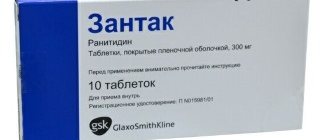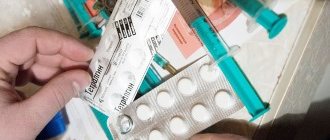Pharmacodynamics and pharmacokinetics
This drug is a 3rd generation H2-histamine receptor blocker. At the same time, suppression of basal and stimulated by acetylcholine, histamine and gastrin production of hydrochloric acid . of pepsin also decreases , and the protection of the mucous membranes of the gastrointestinal tract is enhanced, promoting the healing of lesions caused by the influence of hydrochloric acid. There was a cessation of gastrointestinal bleeding and scarring of ulcers caused by stress occurs due to an increase in the formation of mucus in the stomach, which contains glycoproteins, stimulation of the production of bicarbonate by the gastrointestinal mucosa, endogenous synthesis of prostaglandins and accelerated regeneration. There is no significant change in the concentration of gastrin in the plasma. The oxidase system of cytochrome P450 in the liver area is weakly inhibited. As a result of taking the tablets orally, they begin to act within an hour, the maximum effect is achieved after 3 hours. The effect of the drug lasts 12-24 hours and depends on the dosage.
Inside the body, the drug undergoes rapid absorption from the gastrointestinal tract. Reaching the maximum concentration in the blood plasma occurs after 1-3.5 hours. This medicine is characterized by a bioavailability of about 40-45%, which increases during consumption of food and decreases due to the use of antacids. The drug is slightly bound to plasma proteins. Metabolism occurs in the liver, resulting in the formation of S-oxide. The components of the drug can pass into breast milk and cross the placental barrier. Excretion from the body occurs through the kidneys.
Medicinal properties
Krosacid
After penetration into the body, it inhibits the production of hydrochloric acid, activated by histamine and acetylcholine. Synchronously reduces the activity of the pepsin enzyme and strengthens the immunity of the mucous tissues of the stomach, promotes their faster recovery by stimulating the formation of mucus, prostaglandins and other substances.
Slightly changes the plasma gastrin content, mildly suppresses the hepatic cytochrome P450 system.
Features of pharmacokinetics
After oral administration, it is quickly absorbed from the gastrointestinal tract. In small quantities it binds to plasma proteins and is biotransformed in the liver.
It is excreted from the body by the kidneys; the half-life takes from 2.5 to 4 hours. In patients with renal dysfunction, it increases.
The active substance passes through the placenta and is released into milk.
Indications for use
The use of Gastrosidin is recommended for:
- peptic ulcer of the duodenum and stomach during exacerbation and to prevent relapses;
- treatment and prevention of symptomatic ulcers of the gastrointestinal tract and duodenum, the cause of which is the use of non-steroidal anti-inflammatory drugs, stress or post-operative ulcers;
- erosive gastroduodenitis;
- functional dyspepsia associated with high gastric secretion;
- reflux esophagitis;
- Solinger-Ellison syndrome;
- prevention of recurrent gastrointestinal bleeding;
- and also to prevent aspiration of gastric juice during general anesthesia.
Analogs
There are quite a lot of drugs with similar pharmacological properties , so if you do not find gastrosidin in your pharmacy, you can turn your attention to:
- famotidine,
- famotel,
- famosan,
- pepsidin,
- famopsin,
- quamatel and gasterogen.
All these drugs help in suppressing the production of hydrochloric acid. And they are prescribed by doctors for peptic ulcers.
Video on the topic: Dual Ulcer 12 Prevention and Treatment
Contraindications
Gastrosidin is not prescribed for:
- lactation, pregnancy;
- liver failure;
- childhood;
- intolerance to its components.
Maximum caution is required during treatment of patients suffering from liver cirrhosis , liver dysfunction, portosystemic encephalopathy , and renal failure .
Gastrosidin
Latest update of the description by the manufacturer 31.07.1998
Famotidine* A02BA03 Famotidine
- H2-antihistamines
1 film-coated tablet contains famotidine 40 mg; per package 3 blisters of 10 pcs.
Pharmacological action - antiulcer.
Blocks histamine H2 receptors.
After oral administration, Cmax in plasma is 1–3.5 hours, protein binding is 15–22%. Bioavailability - 37-45%, volume of distribution - 1.1-1.4 l/kg. It is excreted from the body in urine and bile, about 25–30% of the drug is excreted unchanged in the urine. In patients with normal renal function T1/2 is 2.5–4 hours.
After a single dose, the effect lasts 12 hours. It inhibits the release of hydrochloric acid in the stomach (both basal and stimulated by pentagastrin, tetragastrin or betazole).
Taking 40 mg once daily, Gastrosidin reduces nocturnal secretion by an average of 94%. Promotes scarring of stomach and duodenal ulcers.
Does not affect the activity of the liver monooxygenase system and the secretion of prolactin, does not have an antiandrogenic effect.
Duodenal ulcer and benign gastric ulcer (prevention of exacerbations and treatment), pathological conditions associated with increased secretion (including Zollinger-Ellison syndrome).
Hypersensitivity.
Headache, dizziness, disorientation, constipation, increased serum transaminase levels.
Orally, for the treatment of gastric and duodenal ulcers - 40 mg at night for up to 4 weeks (if there is no effect - up to 8 weeks), for the prevention of exacerbations - 20 mg at night for 6 months, for Zollinger-Ellison syndrome - 20 mg every 6 hours (maximum daily dose - 400 mg).
Before starting treatment, it is necessary to ensure that the ulcer is benign. Pregnant women and after childbirth are prescribed in the presence of strict indications and under the supervision of a doctor.
At temperatures below 30 °C (do not freeze).
Keep out of the reach of children.
4 years.
Do not use after the expiration date stated on the package.
Category ICD-10 Synonyms of diseases according to ICD-10
| K25 Stomach ulcer | Helicobacter pylori |
| Pain syndrome with gastric ulcer | |
| Pain syndrome in gastric and duodenal ulcers | |
| Inflammation of the gastric mucosa | |
| Inflammation of the gastrointestinal mucosa | |
| Benign gastric ulcer | |
| Disease of the stomach and duodenum associated with Helicobacter pylori | |
| Exacerbation of gastroduodenitis against the background of peptic ulcer | |
| Exacerbation of peptic ulcer | |
| Exacerbation of gastric ulcer | |
| Organic gastrointestinal disease | |
| Peptic ulcer of the stomach and duodenum | |
| Postoperative gastric ulcer | |
| Ulcer recurrence | |
| Symptomatic stomach ulcers | |
| Symptomatic ulcers of the stomach and duodenum | |
| Helicobacteriosis | |
| Chronic inflammatory disease of the upper gastrointestinal tract associated with Helicobacter pylori | |
| Helicobacter pylori eradication | |
| Erosive and ulcerative lesions of the stomach | |
| Erosive lesions of the stomach | |
| Erosion of the gastric mucosa | |
| Peptic ulcer | |
| Stomach ulcer | |
| Gastric ulcer | |
| Ulcerative lesions of the stomach | |
| K26 Duodenal ulcer | Pain syndrome in duodenal ulcer |
| Pain syndrome in gastric and duodenal ulcers | |
| Disease of the stomach and duodenum associated with Helicobacter pylori | |
| Exacerbation of peptic ulcer | |
| Exacerbation of duodenal ulcer | |
| Peptic ulcer of the stomach and duodenum | |
| Recurrence of duodenal ulcer | |
| Symptomatic ulcers of the stomach and duodenum | |
| Helicobacteriosis | |
| Helicobacter pylori eradication | |
| Erosive and ulcerative lesions of the duodenum | |
| Erosive and ulcerative lesions of the duodenum associated with Helicobacter pylori | |
| Erosive lesions of the duodenum | |
| Duodenal ulcer | |
| Ulcerative lesions of the duodenum | |
| K31 Other diseases of the stomach and duodenum | Discomfort in the stomach area |
| Stress damage to the mucous membrane | |
| K86.8.3* Zollinger-Ellison syndrome | Ulcerogenic pancreatic adenoma |
| Gastrinoma | |
| Gastrinomas | |
| Zollinger-Ellison syndrome |
Source: https://www.rlsnet.ru/tn_index_id_893.htm
Side effects
When treated with Gastrosidin, side effects associated with the digestive, nervous, cardiovascular and reproductive systems may occur.
Undesirable symptoms include: dry mouth, nausea, vomiting, abdominal pain, loss of appetite , headache , dizziness , hallucinations, low blood pressure, bradycardia, gynecomastia, hyperlactinemia, aminorrhea, impotence, and so on.
It is also possible that allergic reactions : dry skin, urticaria , skin itching and rashes, bronchospasm, angioedema and anaphylactic shock.
Sometimes there are disturbances in the functioning of the sensory organs and hematopoiesis, manifested by leukopenia, thrombocytopenia, hypoplasia, accommodation paresis , blurred vision, tinnitus and other symptoms.
Similar drugs:
- Omez Capsule
- Omeprazole Capsule
- Ortanol Capsule
- Omez D Capsule
- Calcium carbonate Substance-powder
- Zulbeks Oral tablets
- Rabeprazole Oral tablets
- Quamatel Lyophilisate for the preparation of a solution for intracavernous administration
- De-Nol Oral tablets
- Metronidazole Injection solution
** The Drug Directory is intended for informational purposes only. For more complete information, please refer to the manufacturer's instructions. Do not self-medicate; Before starting to use the drug Gastrosidin, you should consult a doctor. EUROLAB is not responsible for the consequences caused by the use of information posted on the portal. Any information on the site does not replace medical advice and cannot serve as a guarantee of the positive effect of the drug.
Are you interested in the drug Gastrosidin? Do you want to know more detailed information or do you need a doctor's examination? Or do you need an inspection? You can make an appointment with a doctor - the Euro lab is always at your service! The best doctors will examine you, advise you, provide the necessary assistance and make a diagnosis. You can also call a doctor at home . Euro lab clinic is open for you around the clock.
** Attention! The information presented in this medication guide is intended for medical professionals and should not be used as a basis for self-medication. The description of the drug Gastrosidin is provided for informational purposes and is not intended for prescribing treatment without the participation of a doctor. Patients need to consult a specialist!
If you are interested in any other drugs and medications, their descriptions and instructions for use, information about the composition and form of release, indications for use and side effects, methods of use, prices and reviews of drugs, or you have any other questions and suggestions - write to us, we will definitely try to help you.
Gastrosidin, instructions for use (Method and dosage)
The tablets are taken orally and are prescribed in a dosage corresponding to the type of disorder. In this case, the tablets should be swallowed whole with plenty of water.
For the treatment of exacerbations of gastric and duodenal ulcers, symptomatic ulcers, erosive gastroduodenitis, the drug is prescribed in a daily dosage of 20 mg twice or 40 mg once, preferably at night. If necessary, the daily dosage is increased to 80-160 mg. Duration of therapy is 4-8 weeks.
During dyspepsia, which is caused by the secretory function of the stomach, tablets are prescribed in a daily dosage of 20 mg for 1-2 times.
If prevention of relapses of peptic ulcer is necessary, the medicine is prescribed in a dosage of 20 mg per single dose.
For the treatment of reflux esophagitis, it is recommended to take the drug twice a day at a dosage of 20-40 mg for 6-12 weeks.
Therapy for Solinger-Ellison syndrome involves establishing an individual dosage and treatment course. In this case, the initial dosage can be 20 mg; tablets should be taken at 6-hour intervals; if necessary, increase to 160 mg.
When prophylactic measures for aspiration of gastric juice are carried out using general anesthesia, the medicine is prescribed in the evening or morning before surgery at a dose of 40 mg.
Gastrosidine tablets
The instructions are present in each of the packages of the drug Gastrosidin, serving to inform the patient with gastrointestinal problems about the use and effect of the tablets.
Indications for use of Gastrosidin
It is advisable to use Gastrosidin in cases where the patient has:
- duodenal/gastric ulcer, both during exacerbations and to prevent relapses;
- Zollinger-Ellison syndrome;
- erosive gastroduodenitis;
- symptomatic ulcers in the gastrointestinal tract due to stress, surgery or long-term treatment with NSAIDs;
- reflux esophagitis;
- functional dyspepsia due to increased production of gastric juice.
Also, recommendations for taking the drug can be obtained for prophylactic purposes regarding the prevention of recurrent bleeding in the digestive tract or aspiration of gastric juice during general anesthesia.
Instructions for use of Gastrosidin tablets
Take Gastrosidin tablets by swallowing them whole and drinking plenty of water.
Erosive gastroduodenitis, symptomatic ulcers, exacerbation of gastric/duodenal ulcers
Prescribed 20 mg/2r or 40 mg/1r preferably before bedtime. If necessary, daily intake can be increased to 80 (160) milligrams. Duration of treatment is from one to two months.
Functional dyspepsia
Take 20 mg/1 or 2 times/day.
Preventative measures for ulcer recurrence
Recommended dose is 20 mg/day.
Reflux esophagitis
Prescribed 20 or 40 mg/2 times/day. from one and a half to three months.
Zollinger-Ellison syndrome
Dosing is individual. The recommended initial dose is 20 mg/every 6 hours up to 160 mg.
For the purpose of prevention of aspiration of gastric juice before giving general anesthesia
The drug is recommended to be taken on the eve of surgery at night 40 milligrams.
For children
There have not been enough clinical studies in children to confirm the safety of Gastrosidin.
Side effects
The side effects of the drug are as follows:
Digestive system
- loss of appetite;
- increased plasma levels of transaminases;
- feeling of dryness in the mouth;
- cholestatic jaundice;
- perversion of taste;
- diarrhea/constipation;
- nausea, vomiting;
- bloating.
Nervous system
- headache;
- mental disorders of a transient nature;
- noise in ears;
- high degree of fatigue.
Cardiovascular system
In rare cases, arrhythmia has been reported.
Hematopoietic system
The development of agranulocytosis, thrombocytopenia, leukopenia, and pancytopenia was rarely recorded.
Bone/muscle system
Feelings of pain in muscles/joints.
Allergic reaction
- Feverish state;
- itchy skin;
- development of bronchospasm.
Dermatological reaction
- Feeling of dry skin;
- alopecia;
- common eel.
Drug interactions
When combining Gastrosidin with some medications, the following drug interactions may occur:
- anticoagulants – increases the risk of bleeding;
- antacids – decreased absorption of Gastrosidin;
- itraconazole – decrease in its effect;
- nifedipine – there is a description of a case of decreased cardiac output and cardiac output;
- norfloxacin – its plasma concentration decreases;
- probenecid - increasing plasma concentrations of famotidine;
- phenytoin – increased plasma concentration with possible development of toxicity;
- cefpodoxime – bioavailability becomes lower;
- cyclosporine - increased concentration in blood plasma.
Additional instructions
Before starting treatment with this drug, it is advisable to conduct an examination to exclude malignant neoplasms in the digestive tract.
Treatment withdrawal is completed gradually to avoid rebound syndrome.
If a weakened patient is treated with Gastrosidin for a long time, his stomach may suffer from bacterial damage, which can lead to further spread of the infection.
To get a real picture of testing the acid-forming functionality of the stomach, as well as skin tests for histamine reactions, it is necessary to stop taking the drug several days before the test.
Driving and other activities where it is necessary to concentrate requires caution when taking Gastrosidin tablets
Interaction
Due to the increased pH of the gastric contents, combined use with Ketoconazole and Intraconazole may reduce their absorption.
Simultaneous use with Sucralfate and antacid drugs may reduce the intensity of absorption of famotidine, for this reason it is necessary to maintain an interval between doses of at least 1-2 hours.
Any medications that can have a depressant effect on the bone marrow increase the risk of developing neutropenia .
Combination with Amoxicillin and Clavulanic acid increases their absorption.
pharmachologic effect
Kvamatel tablets - instructions for use
Gastrosidin is a drug used to treat peptic ulcers. Gastrosidine contains famotidine, an inhibitor of H2-histamine receptors, which, unlike other known drugs in this group, contains a substituted thiazole ring in its structure.
Famotidine blocks the effect of histamine on H2-specific receptors, as a result of which gastric secretion of hydrochloric acid (including stimulated and basal) decreases.
Famotidine weakly dissociates in complex with H2 receptors, which ensures its effectiveness. When inhibiting stimulated production of hydrochloric acid, famotidine is more active in a molar ratio than ranitidine and cimetidine (3-20 and 20-150 times, respectively).
Famotidine is used in hyperacid conditions and to reduce gastric secretion in case of ulcerative damage to the duodenal mucosa, as well as gastroesophageal reflux.
Pharmacokinetics
After oral administration, famotidine is rapidly absorbed and reaches peak serum levels 1–2 hours after administration. The half-life of famotidine is 2–3 hours. Average bioavailability is 40–50% (individual variability is possible).
Famotidine is excreted predominantly by the urinary system (65–70%) unchanged.
special instructions
Before starting treatment, the presence of malignant diseases of the stomach , esophagus or duodenum should be excluded. After completion of treatment, this drug, like other H2-histamine blockers, is not recommended to be abruptly discontinued, as this can cause rebound syndrome.
Long-term therapy of weakened patients in stressful situations can lead to bacterial lesions of the stomach and subsequent spread of infection.
H2 histamine receptor blockers are able to prevent the influence of histamine and pentagastrin on the acid-forming function of the stomach. For this reason, the use of H2-histamine receptor blockers is not recommended during the day before the test. Also, these drugs suppress skin reactions to histamine, causing false negative results (prior to diagnostic skin tests to detect immediate allergic skin reactions, the use of H2-histamine receptor blockers should be discontinued. During treatment, it is necessary to refrain from consuming any food, food products and drugs that cause irritation of the gastrointestinal mucosa.
During treatment, care must be taken when driving vehicles and performing any activity that requires high concentration and reaction speed.
Instructions for the drug Gastrosidin
The antiulcer agent is produced in coated tablets. Contents of components in 1 pill:
- 20 mg famotidine
- Core: milk sugar, corn starch, polysorb, E 572
- Coating: hydroxypropyl methylcellulose, E 463, PEG 6000, E 172 (red), E 172 (yellow), talc, E 171.
The instructions are present in each of the packages of the drug Gastrosidin, serving to inform the patient with gastrointestinal problems about the use and effect of the tablets.
The tableted medicine Gastrosidin is packaged in blisters in the amount of ten pieces and laid out in cardboard paper packages of three or one blisters in each.
The main active ingredient of the drug is famotidine. It is supplemented with lactose, red and yellow iron oxides, magnesium stearate, propylene glycol 6000, corn starch, titanium dioxide, colloidal silicon dioxide, hydroxypropylcellulose, talc and hypromellose.
Storage of the drug is organized in rooms at room temperature, away from children. The shelf life of the drug is up to four years.
Pharmacology
The third generation histamine H2 receptor blocker, due to its pharmacological properties, promotes:
- suppression of hydrochloric acid secretion, both stimulated and basal;
- decreased pepsin activity;
- strengthening the protective ability of the mucous membrane of the digestive tract;
- eliminating bleeding in the gastrointestinal tract;
- scarring of ulcerative lesions.
The effect of the drug manifests itself within an hour after administration, with the maximum effect achieved after three hours. The duration of action of the medicine can last up to a day, depending on the dose taken.
Pharmacokinetics
Absorption after administration of the drug is quite rapid. The maximum plasma concentration can be achieved within an hour, but up to three and a half hours is required. Bioavailability is no more than 45 percent, with a tendency to increase when taken with food and decrease when combined with antacids. The connection with plasma protein is negligible.
The drug is metabolized with the subsequent formation of S-oxide in the liver. Excretion is carried out by the kidneys.
It is known that famotidine penetrates into the milk of a nursing woman and overcomes the placenta barrier.
Gastrosidin analogs
Level 4 ATC code matches:
Gistak
Ranitidine
Acylok
Cimetidine
Zantac
Kvamatel
Famotidine
Main analogues: Kvamatel, Famosan, Ulfamid and Famotidine.
Gastrosidin for peptic ulcers
Stomach ulcer is a chronic disease. It is characterized by the fact that various ulcerative defective formations occur in the gastric mucosa. Most often, this disease occurs due to poor diet or lifestyle.
But still, the main reason lies in the imbalance between the protective mechanisms of the stomach and aggressive factors.
The development of peptic ulcer disease occurs from the action of the microbe Helicobacter pylori, which, through its vital activity, affects the gastric mucosa.
There are quite a lot of drugs on the market that can combat ulcers, heartburn, acidity disorders, and so on. One of these drugs is Gastrosidin.
Instructions for use
The instructions for Gastrosidin contain complete information about the nuances of the drug’s composition, the mechanism of its effect on the body and pharmacological properties.
In separate paragraphs, the manufacturer describes pathological conditions in which taking the medication is prohibited and possible side effects. The dosage regimen and dosage regimen for the antiulcer agent can be adjusted by your doctor.
Additionally, the instructions describe the drug interactions of Gastrosidin, special instructions and general recommendations for storing the medication.
pharmachologic effect
Gastrosidine belongs to the category of H2-histamine receptor blockers (second generation). The antiulcer not only improves the patient’s general condition and relieves the symptoms of existing pathologies, but also strengthens the protective functions of the digestive system. Taking the medication ensures accelerated healing of erosions and ulcers on the mucous membranes.
Additionally, Gastrosidin has an effect on the general functional state of the digestive tract.
Pharmacological properties:
- suppression of harmful hydrochloric acid production;
- reducing excessive pepsin activity;
- stopping gastric bleeding;
- restoration of regeneration processes in the tissues of the digestive tract;
- neutralization of the negative effects of hydrochloric acid on the digestive tract;
- preventing recurrence of gastric bleeding;
- accelerating the process of scarring of ulcerative formations;
- improving the functional state of the digestive system;
- stimulating the process of formation of gastric mucus.
Directions for use and dosage
When treating stomach and duodenal ulcers that are in the period of exacerbation, 40 milligrams of the drug are prescribed before bedtime. The duration of the course is approximately four to eight weeks, depending on how quickly the scarring occurs.
In the treatment of Zollinger-Ellison syndrome, the drug is prescribed under special instructions. If the patient has not previously used drugs that suppress secretion, then gastrosidin should be used 20 milligrams every six hours.
To prevent diseases and prevent relapses, the recommended dose of gastrosidin is 20 mg.
Release form
The drug is available in the form of round tablets of light brown color, coated with a separating line, which allows the tablet to be used not entirely. Weight – 40 mg.
The composition includes the active substance - famotidine (H₂-histamine locator, which is used to suppress gastric secretion).
In addition, it contains excipients such as lactose, corn starch, colloidal anhydrous silicon dioxide and magnesium stearate.
The shell consists of : red iron oxide, talc, dioxide, titanium, hypromellose, propylene glycol 6000.
Interaction with other drugs
Concomitant use with antacids or sucralfate is not recommended, as the absorption rate of famotidine may be reduced. You must keep a break between doses, which should be at least 1-2 hours. Neutropenia may develop when used concomitantly with drugs that depress the bone marrow.
Also, when used simultaneously with anticoagulant drugs, the risk of bleeding and increased prothrombin time increases.
Side effects
For the most part, the drug is well tolerated by patients. However, some of the side effects include:
- lack of appetite,
- headache,
- nausea,
- vomit,
- joint pain,
- muscle pain,
- stomach upset,
- constipation,
- tinnitus and allergic reactions,
- Rarely, arrhythmia and increased levels of transaminases in the blood occur.
With very long-term use, decreased libido, impotence and hyperprolactinemia are possible.
Overdose
Exceeding dosages of Gastrosidin can provoke serious pathological conditions. Symptoms of overdose include motor agitation, a significant decrease in blood pressure, tremors of the limbs and tachycardia.
A single violation of the dosage regimen can provoke vomiting and functional abnormalities in the nervous system. The degree of intensity of side symptoms depends on the body’s sensitivity to substances from Gastrosidin.
Other consequences of overdose:
- impotence and decreased libido;
- ringing in the ears and visual disturbances;
- angioedema;
- leukopenia or thrombocytopenia;
- hallucinations and confusion.
Contraindications
Contraindicated during pregnancy (famotidine is excreted in breast milk) and during lactation, as well as in case of hypersensitivity, liver failure, childhood and individual intolerance to the components.
Influence on control of dangerous mechanisms and driving vehicles
Potentially hazardous activities should be undertaken with caution when taking Gastrosidine. In the event of adverse conditions, the concentration of attention and the speed of natural reactions may be impaired.
Pregnancy and lactation
The lactation period and pregnancy are included in the list of absolute contraindications for the use of Gastrosidin.
Use in childhood
Gastrosidin is not intended for use in pediatrics. Children are at risk of adverse symptoms as a result of taking the medication.
For impaired renal function
Severe renal dysfunction is not included in the list of direct contraindications for taking Gastrosidine, but adjustment of the dosage regimen may be required.
For liver dysfunction
Gastrosidin is contraindicated in cases of severe liver dysfunction (the drug can be used for cirrhosis, but only on the basis of doctor’s testimony).
Conditions for dispensing from pharmacies
To purchase Gastrosidin at pharmacies, you will need a prescription.
Storage conditions and periods
Gastrosidin is available from pharmacies with a doctor's prescription. The storage period should not exceed 4 years. After the expiration date, the drug cannot be used.
Gastrosidin must be stored in a dry, dark place out of reach of children at a temperature of 18 to 25 degrees Celsius (do not freeze!).
Price
The average price in Russia and Ukraine is within 150 rubles (58 UAH).
Analogs
There are quite a lot of drugs with similar pharmacological properties , so if you do not find gastrosidin in your pharmacy, you can turn your attention to:
- famotidine,
- famotel,
- famosan,
- pepsidin,
- famopsin,
- quamatel and gasterogen.
All these drugs help in suppressing the production of hydrochloric acid. And they are prescribed by doctors for peptic ulcers.
on the topic: Dual Ulcer 12 Prevention and Treatment
Reviews
“Gastrosidin is a good drug in the fight against stomach ulcers. Although among analogues there are more effective products, the price-quality ratio of the drug is excellent! There are improvements, but you should not use it as a panacea; stomach ulcers are best treated comprehensively and under the strict supervision of a doctor.”
Maria, 34 years old
“The drug is good, but it is very difficult to get. It is not sold in our pharmacies; I had to order it from an online store. I bought it on the recommendation of a doctor. Unlike analogues from a higher price category, there is no difference.”
Selina, 27 years old
“Very useful for gastrointestinal diseases! One small drawback is that you cannot use it for a long time or often, as it is written in the instructions.”
Results
- The use of the drug is not recommended for exacerbations of liver and kidney diseases;
- Before use, you should ensure that there is no malignancy in the gastrointestinal tract;
- When treating with gastrosidin, you should not consume alcohol, foods that irritate the gastric mucosa, as well as sweet carbonated drinks;
- Not intended for the treatment of childhood diseases. Use is recommended from 18 years of age;
- During long-term treatment of peptic ulcer, you should be under strict medical supervision;
- It is not recommended to use the drug if you are hypersensitive to the components;
- Release from pharmacies with a doctor's prescription;
Source: https://gastrocure.net/preparaty/narushenie-kislotnosti/gastrosidin-pri-yazvennoj-bolezni.html
Reviews about Gastrosidin
Quite good reviews about Gastrosidin are left by users who have previously taken other medications. As they report, switching to this drug has alleviated the situation. It works well both as a prophylactic and, of course, for its intended purpose - it perfectly reduces excessive stomach acidity.
Gastrosidin is especially often prescribed for gastritis and helps to quickly eliminate the unpleasant symptoms of this disease. Many patients report that they take the pills at the slightest unwanted sensation in the stomach. Of course, it is not recommended to use this medicine without a doctor's prescription.
There are no descriptions of the development of severe side effects from treatment with Gastrosidin, nor are there any cases of overdose reported. Most people take it for a short time, only to relieve stomach discomfort.
In modern pharmacology, there are a great variety of medications that can reduce stomach acidity. However, not every drug helps every patient. As a rule, it is important to choose a suitable drug that is more tolerated by the patient and gives the most positive therapeutic results. Gastrosidin can become this unique remedy. But it is strongly recommended to undergo an examination and get a prescription from your doctor.
Reviews
“Gastrosidin is a good drug in the fight against stomach ulcers. Although among analogues there are more effective products, the price-quality ratio of the drug is excellent! There are improvements, but you should not use it as a panacea; stomach ulcers are best treated comprehensively and under the strict supervision of a doctor.”
Maria, 34 years old
“The drug is good, but it is very difficult to get. It is not sold in our pharmacies; I had to order it from an online store. I bought it on the recommendation of a doctor. Unlike analogues from a higher price category, there is no difference.”
Selina, 27 years old
“Very useful for gastrointestinal diseases! One small drawback is that you cannot use it for a long time or often, as it is written in the instructions.”
GASTROSIDINE
Film-coated tablets
pinkish-brown in color, round, biconvex, with a dividing groove on one side and a company sign on the other; The core of the tablet is white.
Excipients: lactose, corn starch, colloidal silicon dioxide, magnesium stearate, hydroxypropyl methylcellulose, hydroxypropylcellulose, polyethylene glycol 6000, red iron oxide, yellow iron oxide, talc, titanium dioxide.
10 pieces. – blisters (1) – cardboard packs. 10 pieces. – blisters (3) – cardboard packs.
Pharmacokinetics
After oral administration, it is quickly, but incompletely, absorbed from the gastrointestinal tract. Cmax in blood plasma is reached after 2 hours. Bioavailability is 40-45% and varies slightly in the presence of food.
T1/2 from plasma is about 3 hours and increases in patients with impaired renal function. Protein binding is 15-20%. A small part of the active substance is metabolized in the liver to form famotidine S-oxide. Most of it is excreted unchanged in the urine.
Indications
Treatment and prevention of relapses of gastric and duodenal ulcers, reflux esophagitis, Zollinger-Ellison syndrome, diseases and conditions accompanied by increased secretion of gastric juice, prevention of erosive and ulcerative lesions of the gastrointestinal tract while taking NSAIDs; bleeding from the upper gastrointestinal tract (for intravenous administration, as part of complex treatment).
Dosage
Individual, depending on the indications.
Orally for treatment use 10-20 mg 2 times/day or 40 mg 1 time/day. If necessary, the daily dose can be increased to 80-160 mg. For the purpose of prevention - 20 mg 1 time / day before bedtime.
When administered intravenously, the single dose is 20 mg, the interval between injections is 12 hours.
With CC less than 30 ml/min or with a serum creatinine concentration of more than 3 mg/dL, it is recommended to reduce the dose to 20 mg/day.
From the digestive system:
possible lack of appetite, dry mouth, taste disturbances, nausea, vomiting, bloating, diarrhea or constipation; in some cases - the development of cholestatic jaundice, increased levels of transaminases in the blood plasma.
From the side of the central nervous system:
headaches, increased fatigue, tinnitus, and transient mental disturbances are possible.
From the cardiovascular system:
rarely - arrhythmias.
From the hematopoietic system:
very rarely - agranulocytosis, pancytopenia, leukopenia, thrombocytopenia.
From the musculoskeletal system:
Possible muscle pain and joint pain.
Allergic reactions:
possible skin itching, bronchospasm, fever.
Dermatological reactions:
Alopecia, acne vulgaris, and dry skin are possible.
Local reactions:
irritation at the injection site.
Drug interactions
When used simultaneously with anticoagulants, the possibility of an increase in prothrombin time and the development of bleeding cannot be excluded.
When used simultaneously with antacids containing magnesium hydroxide and aluminum hydroxide, the absorption of famotidine may be reduced.
When used simultaneously with itraconazole, it is possible to reduce the concentration of itraconazole in the blood plasma and reduce its effectiveness.
When used simultaneously with nifedipine, a case of a decrease in cardiac output and cardiac output has been described, apparently due to an increase in the negative inotropic effect of nifedipine.
When used simultaneously with norfloxacin, the concentration of norfloxacin in the blood plasma decreases; with probenecid – the concentration of famotidine in the blood plasma increases.
With simultaneous use, a case of increased plasma concentrations of phenytoin with a risk of toxic effects has been described.
With simultaneous use, the bioavailability of cefpodoxime decreases, apparently due to a decrease in its solubility in the gastric contents when the pH of gastric juice increases under the influence of famotidine.
When used simultaneously with cyclosporine, a slight increase in the concentration of cyclosporine in the blood plasma is possible.
Overdose
Symptoms: vomiting, motor agitation, tremor, decreased blood pressure, tachycardia, collapse.
Interaction with other drugs
. Due to an increase in the pH of the gastric contents, the absorption of ketoconazole and intraconazole may decrease when taken simultaneously. When used simultaneously with antacids or sucralfate, the intensity of absorption of famotidine decreases, so the break between taking these drugs should be at least 1-2 hours. Increased absorption of amoxicillin and clavulanic acid. Bone marrow depressants increase the risk of developing neutropenia.
Pharmacological properties
Pharmacodynamics.
III generation H2-histamine receptor blocker. Suppresses basal and histamine, gastrin and acetylcholine-stimulated production of hydrochloric acid. Reduces pepsin activity. Strengthens the protective mechanisms of the gastric mucosa and promotes the healing of damage associated with the effects of hydrochloric acid (including the cessation of gastrointestinal bleeding and scarring of stress ulcers) by increasing the formation of gastric mucus, the content of glycoproteins in it, stimulating the secretion of bicarbonate by the gastric mucosa, endogenous synthesis of prostaglandins in it and the rate of regeneration. Does not significantly change the concentration of gastrin in plasma. Weakly inhibits the cytochrome P450 oxidase system in the liver. After oral administration, the effect begins within 1 hour and reaches a maximum within 3 hours. The duration of action of the drug after a single dose depends on the dose and ranges from 12 to 24 hours.
Pharmacokinetics.
After oral administration, it is quickly absorbed from the gastrointestinal tract. After oral administration, maximum concentration in blood plasma is achieved within 1-3.5 hours. Bioavailability is 40-45%, increases when taken with food and decreases when taking antacids. Bonding with plasma proteins is 15-20%. 30-35% of famotidine is metabolized in the liver (to form S-oxide). Elimination mainly occurs through the kidneys: 27-40% of the drug is excreted unchanged in the urine. The half-life is 2.5-4 hours, in patients with creatinine clearance below 30 ml/min it increases to 10-12 hours. In patients with severe renal failure (creatinine clearance below 10 ml/min) it increases to 20 hours. Penetrates the placental barrier and is excreted in breast milk.
Release form, packaging and composition of the drug Gastrosidin
Film-coated tablets
light beige, round, biconvex; The core of the tablet is white.
| 1 tab. | |
| famotidine | 20 mg |
Excipients
: lactose, corn starch, colloidal silicon dioxide, magnesium stearate.
Shell composition:
hypromellose, hydroxypropylcellulose, propylene glycol 6000, red iron oxide, yellow iron oxide, talc, titanium dioxide.
10 pieces. - blisters (1) - cardboard packs. 10 pieces. - blisters (3) - cardboard packs.






